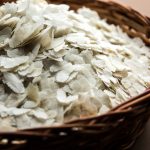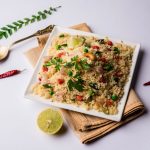Chivda, also spelled as “chiwda” or “chevda,” is a popular and versatile snack in Indian cuisine. It is a dry mixture of various ingredients, typically including fried or roasted items like flattened rice (poha), nuts, lentils, spices, and often some sweetness to balance the flavors. Chivda comes in different regional variations and can be enjoyed as a snack or as a part of traditional Indian festivals and celebrations.
Here are the key elements of chivda in Indian cuisine:
Ingredients:
- Flattened Rice (Poha): This is usually the primary ingredient in chivda. Thin or thick poha is used, depending on the desired texture.
- Nuts: Commonly used nuts include peanuts, cashews, and almonds. They are usually roasted or fried to add crunch and flavor.
- Lentils: Split and skinned lentils like chana dal (split chickpeas) and moong dal (split green gram) are often included for their crispy texture and nutty taste.
- Spices: A blend of spices is added to the chivda mix, which may include ingredients like mustard seeds, cumin seeds, turmeric, red chili powder, and curry leaves. These spices contribute to the savory and spicy flavors.
- Sugar or Jaggery: Some chivda recipes incorporate a bit of sweetness by adding sugar or jaggery. This balances the overall taste, creating a combination of sweet, spicy, and salty flavors.
- Raisins or Dried Fruits: To enhance the sweetness and add a chewy element, dried fruits like raisins are sometimes included.
- Oil: Typically, the various ingredients are fried or roasted in oil to enhance their flavors and achieve the desired texture.
Preparation: The preparation of chivda involves several steps:
- Frying/Roasting: Each ingredient is fried or roasted separately in oil until it becomes crispy and golden. This step is crucial for achieving the right texture and flavor for each component.
- Seasoning: Spices like mustard seeds, cumin seeds, curry leaves, and red chili powder are tempered in hot oil. This seasoned oil is then drizzled over the fried ingredients, infusing them with a burst of flavor.
- Mixing: All the fried and seasoned ingredients are mixed together, and sugar or jaggery may be added at this stage. This is where the sweet and spicy elements come together.
- Cooling: After mixing, the chivda is left to cool completely. This allows the flavors to meld and the chivda to become crisp.
Variations: Chivda can vary significantly based on regional preferences and personal tastes. Some popular variations include:
- Bombay Mix: A popular commercial version of chivda, often featuring a combination of fried noodles, peanuts, peas, and other crunchy elements, with a spicy seasoning.
- Bhadang: A spicy Maharashtrian chivda that includes garlic and spices, known for its bold and fiery flavor.
- Cornflakes Chivda: An innovative version that uses cornflakes along with traditional chivda ingredients, creating a unique texture and flavor.
- Poha Chivda: A lighter version that primarily uses flattened rice, making it crisp and airy.
Chivda is a beloved snack that can be enjoyed with tea or as an accompaniment during festive occasions. Its combination of textures and flavors makes it a delightful treat for snack lovers in India and around the world.


Leave a Reply